

Sedum (Mixed Varieties) (large), is also known as Sedum sp.
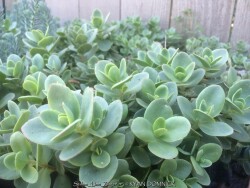

Sedum (Mixed Varieties) (small), is also known as Sedum sp.
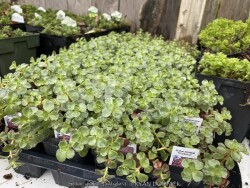

Improved Dragon's Blood Sedum, is also known as Sedum spurium 'Fuldaglut' / 'Fulda Glow'
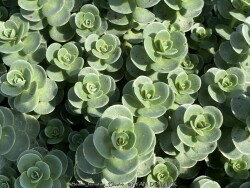

Native White Sedum, is also known as Sedum ternatum
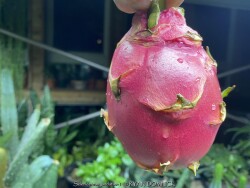

Dragon Fruit cacti are grown for delicious nutritious fruits. This tropical jungle cactus has a few requirements in order to thrive but nothing too hard. Give them bright indirect light and water only when dry. They are usually grown as a house plant in Kansas but can be moved outside if kept in part shade to shade. Leaves can sunburn but morning or filtered sun is ok! Dragon Fruit, like all true cacti, originates in the Americas. It is a sprawling or vining, terrestrial or epiphytic cactus. They climb trees and walls by use of aerial roots and can reach a height of 30 feet in the wild. Protect from temperatures below 45 degrees F and move into a bright window over the winter with no watering. As a winter house plant, it will look presentable all winter long with just a few waterings. Repotting may or may not be needed depending on how large you want the plant to grow; plants can continue to grow in the same pot for years. If repotting, make sure to use a sharp draining highly organic cactus mix with plenty of sand and perlite. This is relatively uncommon plant never seen at the big box stores and will command a higher price than most other houseplants. Plants are usually grown in hanging baskets and take up alot of space. Fruit may or may not occur in this climate; I have seen flowering but not fruit.
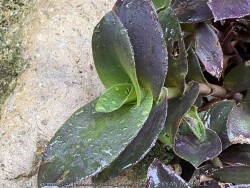

Purple Heart (Setcreasea / Tradescantia pallida) is the most versatile plant in out library: it can be an annual, perennial, patio plant, house plant, or hanging basket in wet or dry soil in full shade or full sun. It can handle growing in standing water or bone dry. In dry soils, it shows no drought stress, continuing to grow with a deeper purple shade. In moist soils, this plant will grow rapidly. In shade, the foliage becomes more greenish but still looks attractive. In Kansas, it is usually grown as an annual. Brilliant purple leaves contrast small pink flowers in the summer! Plants will quickly fill an annual bed with bright purple color all summer til first hard freeze. In the ground, it is possible to overwinter these in the ground in Kansas by placing a giant 6-8" mound of mulch over deeply planted rhizomes. Not sure what's easier, buying and moving that much mulch or replanting in spring?: you decide. If growing as a potted plant and trying to overwinter, allowing the foliage to frost is ok, it will not kill the root system. However, do not allow the pot with rootball to freeze solid or go below 20 degrees for more than a few hours. Allow to go dormant as needed with little care, just cut off dead foliage and place back out in April or May with a time-release fertilizer. Many plants will die back slowly and remain attractive inside for most of the winter. Purple heart plants have no insect, disease or animal pests. Botanical name has recently changed from Setcreasea to Tradescantia. The 'Hardy' form (Setcreasea / Tradescantia pallida 'Bustani Hybrid'), originally purchased at Bustani Plant Farm in Stillwater OK, may have a better chance of surviving winter as a perennial but would still mulch heavy in Kansas. We have not tested this variety for outdoor hardiness in our Lawrence, KS (zone 6a) garden yet (2022). This form also has much more compact foliage and dense root system. When grown in a hanging basket, the foliage creates a nice purple globe effect.


Purple Heart (Setcreasea / Tradescantia pallida 'Purple Heart') is the most versatile plant in out library: it can be an annual, perennial, patio plant, house plant, or hanging basket in wet or dry soil in full shade or full sun. It can handle growing in standing water or bone dry. In dry soils, it shows no drought stress, continuing to grow with a deeper purple shade. In moist soils, this plant will grow rapidly. In shade, the foliage becomes more greenish but still looks attractive. In Kansas, it is usually grown as an annual. Brilliant purple leaves contrast small pink flowers in the summer! Plants will quickly fill an annual bed with bright purple color all summer til first hard freeze. In the ground, it is possible to overwinter these in the ground in Kansas by placing a giant 6-8" mound of mulch over deeply planted rhizomes. Not sure what's easier, buying and moving that much mulch or replanting in spring?: you decide. If growing as a potted plant and trying to overwinter, allowing the foliage to frost is ok, it will not kill the root system. However, do not allow the pot with rootball to freeze solid or go below 20 degrees for more than a few hours. Allow to go dormant as needed with little care, just cut off dead foliage and place back out in April or May with a time-release fertilizer. Many plants will die back slowly and remain attractive inside for most of the winter. Purple heart plants have no insect, disease or animal pests. Botanical name has recently changed from Setcreasea to Tradescantia. This 'Giant' form (Setcreasea / Tradescantia pallida 'Kartuz Giant'), originally purchased at Bustani Plant Farm in Stillwater Oklahoma, has much larger tropical-like foliage. This form survived -16 degrees F and a week of single digit highs in February, 2021 with 3-4" of mulch.
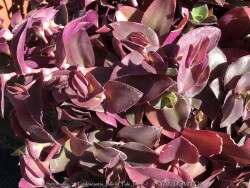

Purple Heart (Setcreasea / Tradescantia pallida 'Purple Heart') is the most versatile plant in out library: it can be an annual, perennial, patio plant, house plant, or hanging basket in wet or dry soil in full shade or full sun. It can handle growing in standing water or bone dry. In dry soils, it shows no drought stress, continuing to grow with a deeper purple shade. In moist soils, this plant will grow rapidly. In shade, the foliage becomes more greenish but still looks attractive. In Kansas, it is usually grown as an annual. Brilliant purple leaves contrast small pink flowers in the summer! Plants will quickly fill an annual bed with bright purple color all summer til first hard freeze. In the ground, it is possible to overwinter these in the ground in Kansas by placing a giant 6-12" mound of mulch over deeply planted rhizomes. Not sure what's easier, buying and moving that much mulch or replanting in spring?: you decide. If growing as a potted plant and trying to overwinter, allowing the foliage to frost is ok, it will not kill the root system. However, do not allow the pot with rootball to freeze solid or go below 20 degrees for more than a few hours. Allow to go dormant as needed with little care, just cut off dead foliage and place back out in April or May with a time-release fertilizer. Many plants will die back slowly and remain attractive inside for most of the winter. Purple heart plants have no insect, disease or animal pests. Botanical name has recently changed from Setcreasea to Tradescantia. The 'Pale Puma' form (Setcreasea / Tradescantia pallida 'Pale Puma') has much more compact foliage and dense root system. When grown in a hanging basket, the foliage creates a purple globe effect. We have not tested this variety for outdoor hardiness in our Lawrence, KS (zone 6a) garden yet (2022).
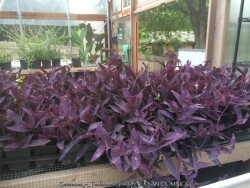

Purple Heart (Setcreasea / Tradescantia pallida 'Purple Heart') is the most versatile plant in out library: it can be an annual, perennial, patio plant, house plant, or hanging basket in wet or dry soil in full shade or full sun. It can handle growing in standing water or bone dry. In dry soils, it shows no drought stress, continuing to grow with a deeper purple shade. In moist soils, this plant will grow rapidly. In shade, the foliage becomes more greenish but still looks attractive. In Kansas, it is usually grown as an annual. Brilliant purple leaves contrast small pink flowers in the summer! Plants will quickly fill an annual bed with bright purple color all summer til first hard freeze. In the ground, it is possible to overwinter these in the ground in Kansas by placing a 6-8" mound of mulch over deeply planted rhizomes. Not sure what's easier, buying and moving that much mulch or replanting in spring?: you decide. If growing as a potted plant and trying to overwinter, allowing the foliage to frost is ok, it will not kill the root system. However, do not allow the pot with rootball to freeze solid or go below 20 degrees for more than a few hours. Allow to go dormant as needed with little care, just cut off dead foliage and place back out in April or May with a time-release fertilizer. Many plants will die back slowly and remain attractive inside for most of the winter. Purple heart plants have no insect, disease or animal pests. Botanical name has recently changed from Setcreasea to Tradescantia. A variegated form is also available. This plant survived in our Lawrence, KS display garden down to -16 degrees F and a week of single digit highs in February, 2021 with mulch.
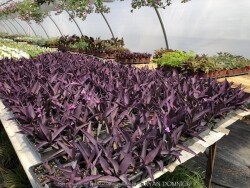

Purple Heart (Setcreasea / Tradescantia pallida 'Purple Heart') is the most versatile plant in out library: it can be an annual, perennial, patio plant, house plant, or hanging basket in wet or dry soil in full shade or full sun. It can handle growing in standing water or bone dry. In dry soils, it shows no drought stress, continuing to grow with a deeper purple shade. In moist soils, this plant will grow rapidly. In shade, the foliage becomes more greenish but still looks attractive. In Kansas, it is usually grown as an annual. Brilliant purple leaves contrast small pink flowers in the summer! Plants will quickly fill an annual bed with bright purple color all summer til first hard freeze. In the ground, it is possible to overwinter these in the ground in Kansas by placing a 6-8" mound of mulch over deeply planted rhizomes. Not sure what's easier, buying and moving that much mulch or replanting in spring?: you decide. If growing as a potted plant and trying to overwinter, allowing the foliage to frost is ok, it will not kill the root system. However, do not allow the pot with rootball to freeze solid or go below 20 degrees for more than a few hours. Allow to go dormant as needed with little care, just cut off dead foliage and place back out in April or May with a time-release fertilizer. Many plants will die back slowly and remain attractive inside for most of the winter. Purple heart plants have no insect, disease or animal pests. Botanical name has recently changed from Setcreasea to Tradescantia. A variegated form is also available. This plant survived in our Lawrence, KS display garden down to -16 degrees F and a week of single digit highs in February, 2021 with mulch.
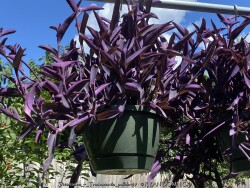

Purple Heart (Setcreasea / Tradescantia pallida 'Purple Heart') is the most versatile plant in out library: it can be an annual, perennial, patio plant, house plant, or hanging basket in wet or dry soil in full shade or full sun. It can handle growing in standing water or bone dry. In dry soils, it shows no drought stress, continuing to grow with a deeper purple shade. In moist soils, this plant will grow rapidly. In shade, the foliage becomes more greenish but still looks attractive. In Kansas, it is usually grown as an annual. Brilliant purple leaves contrast small pink flowers in the summer! Plants will quickly fill an annual bed with bright purple color all summer til first hard freeze. In the ground, it is possible to overwinter these in the ground in Kansas by placing a 6-8" mound of mulch over deeply planted rhizomes. Not sure what's easier, buying and moving that much mulch or replanting in spring?: you decide. If growing as a potted plant and trying to overwinter, allowing the foliage to frost is ok, it will not kill the root system. However, do not allow the pot with rootball to freeze solid or go below 20 degrees for more than a few hours. Allow to go dormant as needed with little care, just cut off dead foliage and place back out in April or May with a time-release fertilizer. Many plants will die back slowly and remain attractive inside for most of the winter. Purple heart plants have no insect, disease or animal pests. Botanical name has recently changed from Setcreasea to Tradescantia. A variegated form is also available. This plant survived in our Lawrence, KS display garden down to -16 degrees F and a week of single digit highs in February, 2021 with mulch.
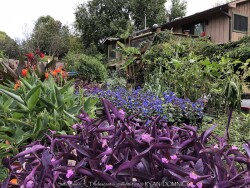

Purple Heart (Setcreasea / Tradescantia pallida 'Purple Heart') is the most versatile plant in out library: it can be an annual, perennial, patio plant, house plant, or hanging basket in wet or dry soil in full shade or full sun. It can handle growing in standing water or bone dry. In dry soils, it shows no drought stress, continuing to grow with a deeper purple shade. In moist soils, this plant will grow rapidly. In shade, the foliage becomes more greenish but still looks attractive. In Kansas, it is usually grown as an annual. Brilliant purple leaves contrast small pink flowers in the summer! Plants will quickly fill an annual bed with bright purple color all summer til first hard freeze. In the ground, it is possible to overwinter these in the ground in Kansas by placing a 6-8" mound of mulch over deeply planted rhizomes. Not sure what's easier, buying and moving that much mulch or replanting in spring?: you decide. If growing as a potted plant and trying to overwinter, allowing the foliage to frost is ok, it will not kill the root system. However, do not allow the pot with rootball to freeze solid or go below 20 degrees for more than a few hours. Allow to go dormant as needed with little care, just cut off dead foliage and place back out in April or May with a time-release fertilizer. Many plants will die back slowly and remain attractive inside for most of the winter. Purple heart plants have no insect, disease or animal pests. Botanical name has recently changed from Setcreasea to Tradescantia. A variegated form is also available. This plant survived in our Lawrence, KS display garden down to -16 degrees F and a week of single digit highs in February, 2021 with mulch.
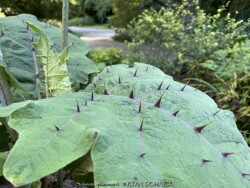

Naranjilla / Bed of Nails (Tropical), is also known as Solanum quitoense


Bluestem Goldenrod (Solidago caesia) is a perennial wildflower with arching blue-green stems is native to the eastern and central parts of the United States and Canada. This woodland goldenrod occurs in open upland woods, shaded bluffs, slopes of wooded ravines and rocky cliffs. Yellow late-summer flowers contrast nicely with bluish purple stems. Considered one of the best plants for solving your most difficult dry-shade landscape challenges and still providing flowers if given at least a couple hours of sun or all-day dappled sun through the trees. Goldenrods are not wind-pollinated and therefore do not cause standard hay fever or allergies. This goldenrod attracts native bees, wasps and pollinating flies. Rabbit and deer resistance is good. This goldenrod has been planted in our trial gardens over 15 years ago on a dry-shade berm with 2-3 hrs of morning sun. The slowly expanding clump is virtually maintenance free, only needing trimmed in fate fall. This species does not spread by rhizomes or runners like some other goldenrods but will self-seed prolifically if you do not mulch. Bluestem Goldenrod is not well known or available in garden centers but worthy of wider scale landscape use.
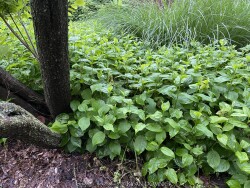

Zig Zag Goldenrod (Solidago flexicaulis) is native to the eastern and central parts of the United States and Canada. This woodland goldenrod, with erect, somewhat zig-zag stems, bears small flower heads at each node along the stem and upper leaves. The oval leaves are a rich green, pointed, and coarsely toothed. Considered one of the best plants for solving your most difficult dry-shade landscape challenges and still providing flowers. Goldenrods are not wind-pollinated and therefore do not cause standard hay fever or allergies. This goldenrod attracts butterflies. Rabbit and deer resistance is good. Zig Zag Goldenrod has been planted in our trial gardens over 10 years ago on a hill in part-sun to dry shade. The slowly expanding clump is virtually maintenance free, only needing trimmed in fate fall. Zig Zag Goldenrod is not well known or available in garden centers but worthy of wider scale landscape use.
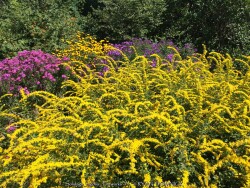

Fireworks Goldenrod (Solidago rugosa 'Fireworks') is the most garden-worthy of the goldenrods! It features dark green upright foliage. As the flower panicle matures, the expanding buds create a fine-textures cloud-like effect for about a month before the flowers open. When the flowers finally open in September, the radiating form really looks like fireworks! After flowering, the dried flower structure holds up well into fall offering winter interest until the first wet heavy snow. The species, Solidago rugosa, is native to the eastern and central parts of the United States and Canada. It is a highly adaptable goldenrod occuring in open moist areas such as low woods, meadows, old fields, pine barrens, and bogs. It is more tolerant of wet soils that other goldenrod. It prefers locations in full sun in average to moist soils that are well-drained but is adaptable to part shade or dappled shade. In Eastern Kansas, typically our 40 inches of rainfall is sufficient without extra water if planted in good soils. During the drought years in Eastern Kansas of 2011 and 2012, many Fireworks Goldenrods planted in landscapes that were not watered survived but dried up as flowers were trying to form. Goldenrods are not wind-pollinated and therefore do not cause standard hay fever or allergies. This goldenrod attracts wide variety of insects, including small bees, wasps, flies, small butterflies. Rabbit and deer resistance is good. The slowly expanding clump is virtually maintenance free, only needing trimmed in fate fall. Fireworks Goldenrod is generally very pest and disease resistant and can spread by creeping rhizomes or seed. Fireworks Goldenrod has been planted in our trial gardens over 18 years in mostly full sun with average garden soil. This is among our favorite perennials with truely 4 seasons of interest!
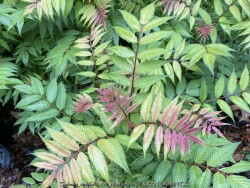

>>>>>Fabulously funky! Mr. Mustard boasts extraordinarily colorful foliage - yellow, orange, red, pink, and lime green meld together in springtime to make a truly memorable show. By summertime, the foliage mellows to a vibrant Kelly green and complements the fabulous creamy white flowers. These large, astilbe-like blooms attract butterflies and pollinators and its suckering habit lends a naturalized look to any garden. With some annual pruning, it easily keeps its mounded habit, suiting it perfectly for mixed beds. >>>>>>All Proven Winners® plants are legally propagated, healthy and vigorous, true to name, and tagged with color pictures and growing information. >>>>>>>>Ultra cold-hardy plants from northern climates normally dislike our long hot humid summers; although we are on the Southern edge of this plants adaptability, it still survives reasonably well here. Look for a cold microclimate planting location such as East or North exposure.>>>>>
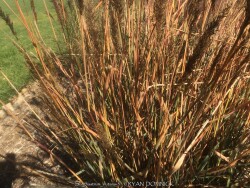

Indian Grass (Sorghastrum nutans) is easily grown in average, dry to medium, well-drained soils in full sun. It is tolerant of a wide range of soils and growing conditions but tends to flop in rich moist soils. This ornamantal grass is a tall, Kansas native, perennial, warm season grass that dominates much of the tall grass prairie extending into the Flint Hills. In fact, Indiangrass, Big bluestem, Little bluestem, and Switchgrass comprise 75% of the species in this ecosystem. It may be grown as an ornamental grass because of its attractive foliage which changes color seasonally along with its good architectural height and its interesting yellow flower/seed heads. Indian Steel Indian Grass (Sorghastrum nutans 'Indian Steel') has improved bluish green foliage that turns yellow in fall and retain some gold color throughout the winter. Feathery panicles of tan-yellow flowers appear well above the foliage in late summer to early fall adding winter interest
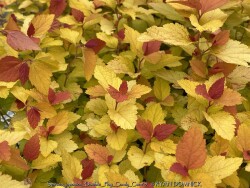

Double Play Candy Corn Spirea, is also known as Spiraea japonica 'Double Play Candy Corn'
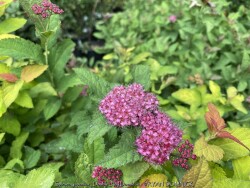

Double Play Doozie Spirea, is also known as Spiraea japonica 'Double Play Doozie'
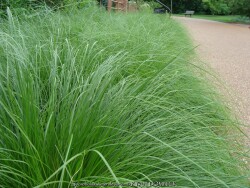

Prairie Dropseed, is also known as Sporobolis heterolepis


Prairie Dropseed, is also known as Sporobolis heterolepis
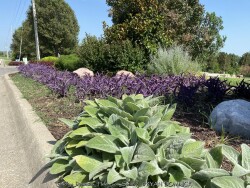

Helen Von Stein Lambs Ear, is also known as Stachys byzantina 'Helen Von Stein'
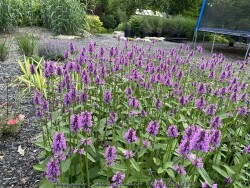

Hummelo Stachys (small), is also known as Stachys monieri / officinalis 'Hummelo'
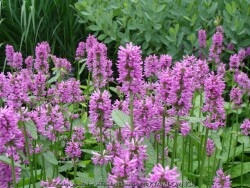

Hummelo Stachys (flat), is also known as Stachys monieri / officinalis 'Hummelo'


Hummelo Stachys (large), is also known as Stachys monieri / officinalis 'Hummelo'
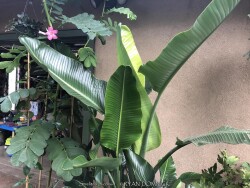

White Bird of Paradise (Tropical), is also known as Strelitzia nicolai
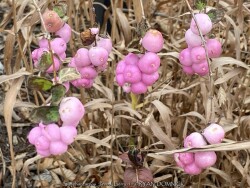

Coralberry (Symphoricarpos orbiculatus) is a spreading dwarf shrub native to much of the central and eastern United States including Kansas. It features mint green leaves that remain attractive all summer. Light pink flowers are barely noticeable but attractive upon close inspection. Ornamental clusters of magenta berries in the fall are the main attraction! The berries are very freeze-hardy clinging onto the leafless stems throughout most of the winter regardless of the minimum temperatures. This creates quite a show providing excellent color and interest to the winter landscape. While edible for some birds including robins, they seem to avoid the fruits unless it's a last resort. Coralberry is commonly grown as a spreading groundcover shrub for difficult areas. It will grow in full sun or full shade in medium to dry soils including dry-shade. It tolerates moist soil and floods for short periods of time. Fall leaf color is non-existent but ok because of the berry display. A brief window of time exists in the fall where the plant has beautiful green foliage and contrasting magenta berries at the same time. In the landscape, it is commonly used as large mass planting on hills. Because of its tolerance for adverse conditions including poor soil and rock, it is often one of the last resort plants that will survive in certain areas. It competes well under large shade trees and helps absorb leaf litter allowing it to break down and add nutrients back to the soil. This plant also does well in full sun; berry density is much greater in full sun. Plants can also be planted on the north side of a house, being extremely cold hardy with no winterkill. Another great spot is planting on top of a retaining wall allowing it to cascade down. We do not recommend planting in small areas or in spaces that it will overrun neighboring plants. It only spreads above ground as horizontally growing stems touch the ground and root. This does make maintenance easier to control the spread of the plant versus digging out rhizomes. Considered one of the best plants for solving your most difficult dry-shade landscape challenges. Proud Berry Pink Coralberry (Symphoricarpos 'Proud Berry') is a Proven Winners® selection that has much larger pink berries in large clusters. Fruit lasts into December but is quicker to dessicate than the true native magenta coralberry. All Proven Winners® plants are legally propagated, healthy and vigorous, true to name, and tagged with color pictures and growing information.
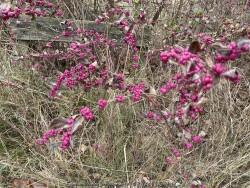

Coralberry (Symphoricarpos orbiculatus) is a spreading dwarf shrub native to much of the central and eastern United States including Kansas. It features mint green leaves that remain attractive all summer. Light pink flowers are barely noticeable but attractive upon close inspection. Ornamental clusters of magenta berries in the fall are the main attraction! The berries are very freeze-hardy clinging onto the leafless stems throughout most of the winter regardless of the minimum temperatures. This creates quite a show providing excellent color and interest to the winter landscape. While edible for some birds including robins, they seem to avoid the fruits unless it's a last resort. Coralberry is commonly grown as a spreading groundcover shrub for difficult areas. It will grow in full sun or full shade in medium to dry soils including dry-shade. It tolerates moist soil and floods for short periods of time. Fall leaf color is non-existent but ok because of the berry display. A brief window of time exists in the fall where the plant has beautiful green foliage and contrasting magenta berries at the same time. In the landscape, it is commonly used as large mass planting on hills. Because of its tolerance for adverse conditions including poor soil and rock, it is often one of the last resort plants that will survive in certain areas. It competes well under large shade trees and helps absorb leaf litter allowing it to break down and add nutrients back to the soil. This plant also does well in full sun; berry density is much greater in full sun. Plants can also be planted on the north side of a house, being extremely cold hardy with no winterkill. Another great spot is planting on top of a retaining wall allowing it to cascade down. We do not recommend planting in small areas or in spaces that it will overrun neighboring plants. It only spreads above ground as horizontally growing stems touch the ground and root. This does make maintenance easier to control the spread of the plant versus digging out rhizomes. Considered one of the best plants for solving your most difficult dry-shade landscape challenges.
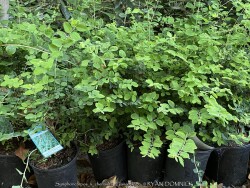

Coralberry (Symphoricarpos orbiculatus) is a spreading dwarf shrub native to much of the central and eastern United States including Kansas. It features mint green leaves that remain attractive all summer. Light pink flowers are barely noticeable but attractive upon close inspection. Ornamental clusters of magenta berries in the fall are the main attraction! The berries are very freeze-hardy clinging onto the leafless stems throughout most of the winter regardless of the minimum temperatures. This creates quite a show providing excellent color and interest to the winter landscape. While edible for some birds including robins, they seem to avoid the fruits unless it's a last resort. Coralberry is commonly grown as a spreading groundcover shrub for difficult areas. It will grow in full sun or full shade in medium to dry soils including dry-shade. It tolerates moist soil and floods for short periods of time. Fall leaf color is non-existent but ok because of the berry display. A brief window of time exists in the fall where the plant has beautiful green foliage and contrasting magenta berries at the same time. In the landscape, it is commonly used as large mass planting on hills. Because of its tolerance for adverse conditions including poor soil and rock, it is often one of the last resort plants that will survive in certain areas. It competes well under large shade trees and helps absorb leaf litter allowing it to break down and add nutrients back to the soil. This plant also does well in full sun; berry density is much greater in full sun. Plants can also be planted on the north side of a house, being extremely cold hardy with no winterkill. Another great spot is planting on top of a retaining wall allowing it to cascade down. We do not recommend planting in small areas or in spaces that it will overrun neighboring plants. It only spreads above ground as horizontally growing stems touch the ground and root. This does make maintenance easier to control the spread of the plant versus digging out rhizomes. Considered one of the best plants for solving your most difficult dry-shade landscape challenges. Symphoricarpos x chenaultii 'Hancock' in a dwarf variety maxing out at 18-24" tall.


***Description for this perennial available with future update!*** >>>>>> This fall blooming aster does not splay open like other Asters can. According to Walters Gardens "Bringing refinement to fall blooming Asters, 'Grape Crush' produces a large, very round mound with densely packed flowers. We have observed no lodging in our trials, a phenomenal achievement for fall blooming Asters. Very rich, dark purple flowers are produced above dark green foliage in early fall to midfall. A perfect finale to the growing season!" Asters are native to North America and are generally very easy to grow.
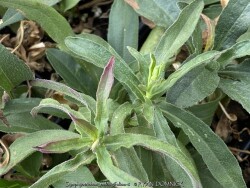

***Description for this perennial available with future update!***
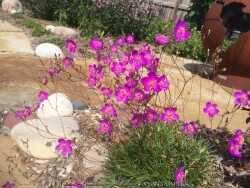

This tiny perennial wildflower (Talinum / Phemeranthus calycinum) produces ascending stems 2-6" long topped with bright magenta flowers. The cluster of bright green foliage at the base is only a few inches tall and resembles round tubes giving it a succulent look. Blooming occurs in mass, each flower lasting only 1 afternoon, but repeating all summer with available moisture. Fame Flower is native to a large area of the great plains to the eastern woods of Missouri and Arkansas. This cold hardy succulent occupies an unusual niche: growing in extremely shallow sandstone based soils and on sunny rock cliffs that dry out too quickly for most other plants to colonize. A good question is how does it find such isolated areas to colonize in the first place? Grow this small native gem in a rock garden, in cracks between rocks, or on top of or in a retaining wall. It will re-seed to thicken the colony but only germinate in bare thin soils with no mulch. It will not tolerate competition in rich moist soils as other plants will shade it out. If grown in pots and kept on the dry side, you may leave out all winter allowing to freeze solid; plants will either return from dormant stems or reseed in the same pot. Great low maintenance cold hardy succulent.
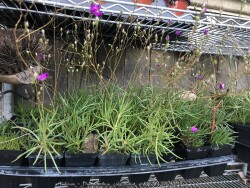

This tiny perennial wildflower (Talinum / Phemeranthus calycinum) produces ascending stems 2-6" long topped with bright magenta flowers. The cluster of bright green foliage at the base is only a few inches tall and resembles round tubes giving it a succulent look. Blooming occurs in mass, each flower lasting only 1 afternoon, but repeating all summer with available moisture. Fame Flower is native to a large area of the great plains to the eastern woods of Missouri and Arkansas. This cold hardy succulent occupies an unusual niche: growing in extremely shallow sandstone based soils and on sunny rock cliffs that dry out too quickly for most other plants to colonize. A good question is how does it find such isolated areas to colonize in the first place? Grow this small native gem in a rock garden, in cracks between rocks, or on top of or in a retaining wall. It will re-seed to thicken the colony but only germinate in bare thin soils with no mulch. It will not tolerate competition in rich moist soils as other plants will shade it out. If grown in pots and kept on the dry side, you may leave out all winter allowing to freeze solid; plants will either return from dormant stems or reseed in the same pot. Great low maintenance cold hardy succulent.
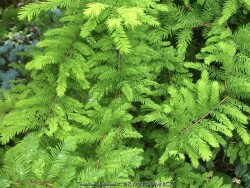

Bald Cypress (Taxodium distichum) is a well-known picturesque tree native to the southeast from Texas to Florida to Virginia. It is a deciduous conifer that grows on saturated and seasonally inundated soils but also performs well an average garden soils including some drought. Trees can be very long lived due to near immunity from pests and disease with some specimens over 2000 years old. When growing in standing water (exclusively), the characteristic knees develop. These are thought to assist an oxygen exchange or to trap sediment along a channel to stabilize the creek bank. Growth is slow during youth especially and dryer sites or poor soils but speeds up in rich well-drained soils. This non-flowering tree features extremely fine textured foliage that creates its own attractive mulch under the tree or blends in invisibly into the lawn. Most references indicate that acidic soil is important however I have seen these growing in pure white limestone alkaline streams in Austin Texas. The water was cyystal clear and pH was so high that not many other organisms for growing in it. Bald Cypress makes a beautiful street tree or residential landscape specimen that will be highly prized after a decade or two. Reserve for the wet test spot in your yard and it will thrive!
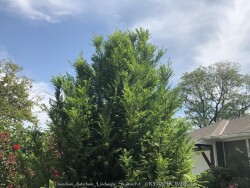

Bald Cypress (Taxodium distichum) is a well-known picturesque tree native to the southeast from Texas to Florida to Virginia. It is a deciduous conifer that grows on saturated and seasonally inundated soils but also performs well an average garden soils including some drought. Trees can be very long lived due to near immunity from pests and disease with some specimens over 2000 years old. When growing in standing water (exclusively), the characteristic knees develop. These are thought to assist an oxygen exchange or to trap sediment along a channel to stabilize the creek bank. Growth is slow during youth especially and dryer sites or poor soils but speeds up in rich well-drained soils. This non-flowering tree features extremely fine textured foliage that creates its own attractive mulch under the tree or blends in invisibly into the lawn. Most references indicate that acidic soil is important however I have seen these growing in pure white limestone alkaline streams in Austin Texas. The water was cyystal clear and pH was so high that not many other organisms for growing in it. Bald Cypress makes a beautiful street tree or residential landscape specimen that will be highly prized after a decade or two. Reserve for the wet test spot in your yard and it will thrive! Taxodium distichum 'Lindsey's Skyward' is a columnar upright form great for screening.
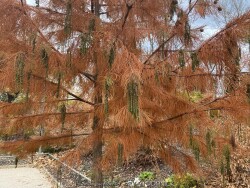

Bald Cypress (Taxodium distichum) is a well-known picturesque tree native to the southeast from Texas to Florida to Virginia. It is a deciduous conifer that grows on saturated and seasonally inundated soils but also performs well an average garden soils including some drought. Trees can be very long lived due to near immunity from pests and disease with some specimens over 2000 years old. When growing in standing water (exclusively), the characteristic knees develop. These are thought to assist an oxygen exchange or to trap sediment along a channel to stabilize the creek bank. Growth is slow during youth especially and dryer sites or poor soils but speeds up in rich well-drained soils. This non-flowering tree features extremely fine textured foliage that creates its own attractive mulch under the tree or blends in invisibly into the lawn. Most references indicate that acidic soil is important however I have seen these growing in pure white limestone alkaline streams in Austin Texas. The water was cyystal clear and pH was so high that not many other organisms for growing in it. Bald Cypress makes a beautiful street tree or residential landscape specimen that will be highly prized after a decade or two. Reserve for the wet test spot in your yard and it will thrive! Pond Cypress (Taxodium distichum var. imbricarium) in now considered a naturally occuring variety of Bald Cypress. Its old name was Taxodium ascendens. In comparison to Bald Cypress, Pond Cypress is somewhat smaller, more narrow, less branching and has very interesting scale-like spirally arranged leaves.
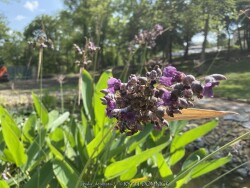

>>>>>This plant is usually grown as a bog plant needing constantly moist soil rich in organic matter. As a rain garden plant, it will thrive is a depressed area in the landscape that collects rain water from a roof during spring and summer periods of rain but then is amazingly drought tolerant if the water hole dries out.
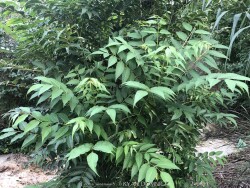

Chinese Toon (Toona sinensis) is a rare shrub-like tree from China in the mahogany family known for its edible leafy foliage. Foliage has an onion a flavor and can be eaten fresh or mixed into stir-fry vegetable recipes. When emerging in the spring, new foliage is a bright red to pink color and is enhanced by cooler weather in the spring. Bi-pinnate foliage deepens to a medium to dark green as it unfurls throughout the summer and has a strong resemblance in appearance to Tree of Heaven (Ailanthus altissima). Fall color is a gorgeous yellow lasting for a week or two. Chinese Toon is useful in the edible landscape as a "vegetable tree". Also very attractive in the landscape, it can form a background shrub, a specimen shrub, or a small colony. Grow in full sun and just about any well drained soil for best results. Although this grows into a "tree" in southern climates, it will typically freeze down to the ground each year in Lawrence Kansas. (zone 6a) The only maintenance is pruning winter-killed growth to the ground. New rapidly growing water sprout shoots will emerge by mid spring. New foliage is the most tasty to eat, so this works out great for harvesting when grown as a "vegetable tree". Chinese Toon can also be grown as a potted plant moved into a garage or dark basement: it doesn't seem to suffer from being root bound in a pot.
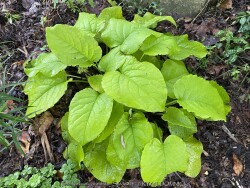

Sundew Oriental Borage / Black Sea Comfrey (Trachystemon orientalis 'Sundew') is a perennial with large textured bright chartreuse leaves with amazing contrasting light blue flowers. It is native from Bulgaria to the Caucasus and Turkey. This variety spreads very slowly by creeping rhizomes and forms an attractive groundcover. Foliage darkens slightly to green in summer and forms a quite dense and tight weed resistant covering. Comfrey prefers rich average to moist well-drained soils with part sun to full shade. However, being a tolerant plant, is very adaptable to both dry and moist locations and will grow quite nicely in dry shade. It is not particular as to soil type or pH. and is highly tolerant of urban pollution and will even thrive in inner city environments. There is virtually no maintenance unless you want to mow down the dead foliage in the winter. It is also suggested to deadhead the flowers after blooming as they are not attractive. But if you don't, they will die back on their own and get swallowed up by the foliage. There are no pest, disease, or browser problems. Considered one of the best plants for solving your most difficult dry-shade landscape challenges. Trachystemon orientalis 'Sundew' has persisted through over a decade in our Lawrence, KS display garden with no problems. Our original display garden plant came from Plant Delights Nursery in North Carolina.
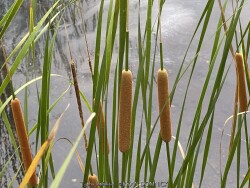

>>>>>This plant is usually grown as a bog plant needing constantly moist soil rich in organic matter. As a rain garden plant, it will thrive is a depressed area in the landscape that collects rain water from a roof during spring and summer periods of rain but then go dormant if the water hole dries out completely. For the home garden, the species is generally too aggressive to mix with other plants
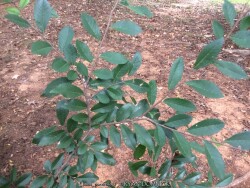

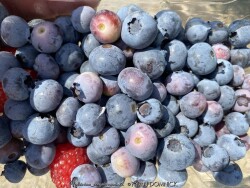

Mixed Highbush Blueberry (Forrest Keeling Hybrids), is also known as Vaccinium corymbosum
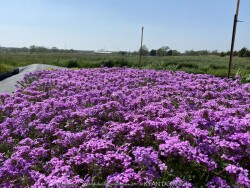

Native Rose Verbena / Glandularia (flat), is also known as Verbena / Glandularia canadensis


Native Rose Verbena / Glandularia, is also known as Verbena / Glandularia canadensis
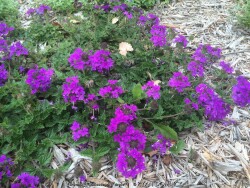

***Description for this plant available with future update!***
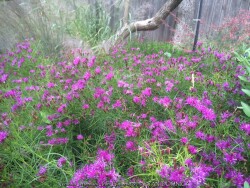

Narrow-leaf Ironweed (Vernonia lettermannii) is a relatively new plant to horticulture; originally discovered in Arkansas along gravel stream beds in the wild. The Iron Butterfly cultivar (Vernonia lettermannii 'Iron Butterfly') is a dwarf compact cultivar introduced by Dr. Allan Armitage at the University of Georgia. This is a true four-seasons perennial that belongs in almost every perennial garden. In the spring, narrow dark green foliage resembling Amsonia hubrichtii creates a compact shrub-like appearance. The growth is so dense that no weeds have a chance of invading a mature stand of plants. By mid to late summer, gorgeous deep purple fine-textured flowers cover the plant for 4-6 weeks. Butterflies, bees, and other pollinators flock to the occasion. Following the bloom, the flower stocks are sturdy and hold up very well for fall and winter interest. The flowers themselves produce mostly non-viable seed and cling to the plant creating a silvery shine whenever sunlight hits it. This can be very useful and dried flower arrangements as well as winter interest gardens. At some point in the winter, all top growth will need to be cut back as this is the only maintenance required. Despite being native to gravel and sand bars along rivers, Iron butterfly Vernonia surprisingly can handle very dry clay, gravelly, or sandy soils along with short periods of flooding. Permanently wet soil is not favored but it can handle the upper portions of a rain garden. Iron butterfly has only one pest problem and that is rabbits! If rabbits are an issue, just put a bowl-shaped chicken wire cage around the plants for the first year. By year #2, the rapidly growing foliage will outgrow any detrimental rabbit browsing. This is definitely one of the most adapted landscape plants in Kansas zone 6a with no problems with heat or cold, dry or wet! It's hard to imagine a perennial garden without this plant!
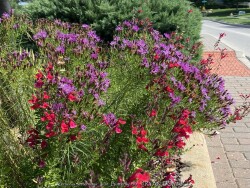

Narrow-leaf Ironweed (Vernonia lettermannii) is a relatively new plant to horticulture; originally discovered in Arkansas along gravel stream beds in the wild. The Iron Butterfly cultivar (Vernonia lettermannii 'Iron Butterfly') is a dwarf compact cultivar introduced by Dr. Allan Armitage at the University of Georgia. This is a true four-seasons perennial that belongs in almost every perennial garden. In the spring, narrow dark green foliage resembling Amsonia hubrichtii creates a compact shrub-like appearance. The growth is so dense that no weeds have a chance of invading a mature stand of plants. By mid to late summer, gorgeous deep purple fine-textured flowers cover the plant for 4-6 weeks. Butterflies, bees, and other pollinators flock to the occasion. Following the bloom, the flower stocks are sturdy and hold up very well for fall and winter interest. The flowers themselves produce mostly non-viable seed and cling to the plant creating a silvery shine whenever sunlight hits it. This can be very useful and dried flower arrangements as well as winter interest gardens. At some point in the winter, all top growth will need to be cut back as this is the only maintenance required. Despite being native to gravel and sand bars along rivers, Iron butterfly Vernonia surprisingly can handle very dry clay, gravelly, or sandy soils along with short periods of flooding. Permanently wet soil is not favored but it can handle the upper portions of a rain garden. Iron butterfly has only one pest problem and that is rabbits! If rabbits are an issue, just put a bowl-shaped chicken wire cage around the plants for the first year. By year #2, the rapidly growing foliage will outgrow any detrimental rabbit browsing. This is definitely one of the most adapted landscape plants in Kansas zone 6a with no problems with heat or cold, dry or wet! It's hard to imagine a perennial garden without this plant!
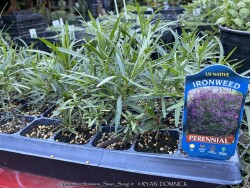

***Description for this perennial available with future update!*** >>>>> Narrow-leaf Ironweed (Vernonia lettermannii) is a relatively new plant to horticulture; originally discovered in Arkansas along gravel stream beds in the wild. The Iron Butterfly cultivar (Vernonia lettermannii 'Iron Butterfly') is a dwarf compact cultivar introduced by Dr. Allan Armitage at the University of Georgia. This is a true four-seasons perennial that belongs in almost every perennial garden. In the spring, narrow dark green foliage resembling Amsonia hubrichtii creates a compact shrub-like appearance. The growth is so dense that no weeds have a chance of invading a mature stand of plants. By mid to late summer, gorgeous deep purple fine-textured flowers cover the plant for 4-6 weeks. Butterflies, bees, and other pollinators flock to the occasion. Following the bloom, the flower stocks are sturdy and hold up very well for fall and winter interest. The flowers themselves produce mostly non-viable seed and cling to the plant creating a silvery shine whenever sunlight hits it. This can be very useful and dried flower arrangements as well as winter interest gardens. At some point in the winter, all top growth will need to be cut back as this is the only maintenance required. Despite being native to gravel and sand bars along rivers, Iron butterfly Vernonia surprisingly can handle very dry clay, gravelly, or sandy soils along with short periods of flooding. Permanently wet soil is not favored but it can handle the upper portions of a rain garden. Iron butterfly has only one pest problem and that is rabbits! If rabbits are an issue, just put a bowl-shaped chicken wire cage around the plants for the first year. By year #2, the rapidly growing foliage will outgrow any detrimental rabbit browsing. This is definitely one of the most adapted landscape plants in Kansas zone 6a with no problems with heat or cold, dry or wet! It's hard to imagine a perennial garden without this plant!
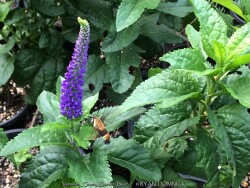

Sunny Border Blue Veronica, is also known as Veronica 'Sunny Border Blue'